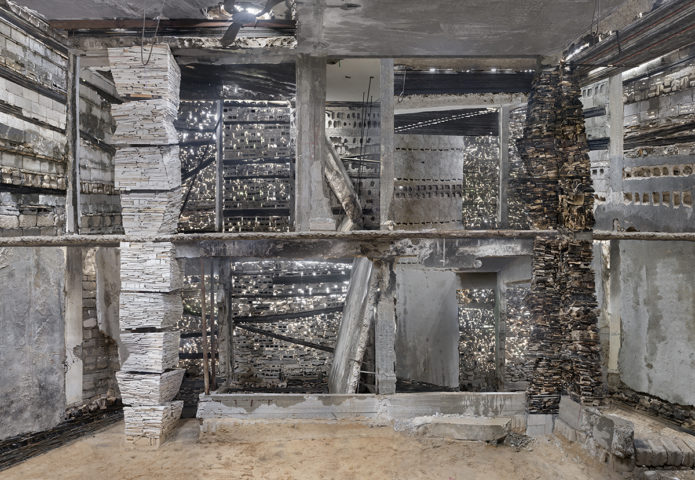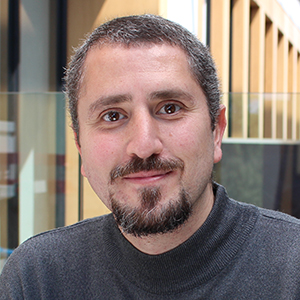 Marjan Teeuwen, Destroyed House Gaza (2016-2017)
Marjan Teeuwen, Destroyed House Gaza (2016-2017) Your Art Work in Gaza, the Rubble House
In response to the Art Work in Gaza by artist Marjan Teeuwen, architect Salem Al Qudwa writes a profound letter to the artist et al. A heartfelt letter which Salem has asked Framer Framed and Uniform November to post on its website, in the hope, it will highlight the consequences of a growing number of experimental or artistic interventions by external parties (regardless of their good intentions) within communities struggling to survive the devastation and trauma of conflict. Salem asks…
“could you please stop having fun in Gaza”.
Dear artist Marjan Teeuwen
Greetings,
I am totally aware that you have used the destruction – not usually a happy moment for architects – of the Shaath building in Khan Younis, the Gaza Strip as an opportunity for making your rubble house installation. While trying to do so, and by reassembling the cement blocks and broken ceramic tiles using the traditional labor techniques, you manipulated the destruction affects: burning some tiles and other objects in order to give the feeling of burning the building and reconstructing it from ash again; a feeling of cinematic super-reality adding to the inherent drama.
Your work is mimicking the American artist (who studied architecture) Matta-Clark*! At least he used abandoned homes and warehouses but in your case study you used a house that belonged to a family; a poor family who is looking to have back its descent home.
I am questioning your social responsibility as an artist towards this family. You managed to get a good amount of money as fund from the EU towards your project. I think this is another kind of experimenting things on the Palestinians without taking into consideration the ethics and moral values towards the poor people. Because of your work, that space can no longer hold its function as a house for people to live in as inhabitants. Instead, you turned it into a museum but for whom? Is it all about getting some fame and publishing a couple of articles in some glossy art magazines?
At any moment, your work could turn to a machine to kill. The stacks of heavy cement blocks and tiles could turn down at any moment. You did not use cement as you stated many times while talking about your work. What if a nearby explosion happened at any time? Who is responsibility it is going to be? Instead of utilising that amount of fund in rehabilitating the house and having the Shaath family back to their home, money is wasted again by someone who tried to have some fun in Gaza.
With great respect to all your artistic talent, your physical efforts and sympathy with the Palestinians in Gaza, kindly, could you please stop having fun in Gaza?
By Salem Al Qudwa,
Architect, Gaza, Palestina / Oxford, England
Augustus 2017
Note:
* Gordon Matta-Clark developed the idea of “anarchitecture” – a conflation of the words anarchy and architecture – to suggest an interest in voids, gaps, and left-over spaces. Later, Matta Clark went on to produce his ‘building cuts’ that further developed ideas of the Anarchitecture group. These were transformations of abandoned buildings, split apart, sliced through and rearranged, commenting once again on society through architecture, touching on the increasing desire for material accumulation, wealth, permanence. (read)
A conversation with the curator
In response to the letter Your Art Work in Gaza, the Rubble House, Framer Framed invited the author Salem Al Qudwa to start a conversation with the curator of the exhibition Meta Knol, to discuss the ‘politics of autonomous art’.
During the event ‘Live conversation HOME #4: The politics of autonomous art‘ the ethics involved while working with autonomous art in a highly politicised environments where discussed. What ethical considerations and social responsibilities are implicated when initiating an art project in a war situation? How can assumptions about the universality of art be assessed when they are posited from a privileged position into a situation of repression? How does the meanings of the artwork change when it travels from the context of Gaza’s public space in the Netherlands, into a highly specific setting of the white cube? Where can we draw the line between ‘autonomous art’ and ‘socially engaged art’?
A report of the discussion can be found here
Middle East / Palestine /
Exhibitions

Exhibition: HOME
With work by Marjan Teeuwen, Ezz Al Zanoon and Rawan Mahady, curated by Meta Knol
Agenda
Live conversation HOME #4: The politics of autonomous art
A panel discussion in the context of the exhibition 'HOME' about the supposed neutrality of autonomous art
Network
